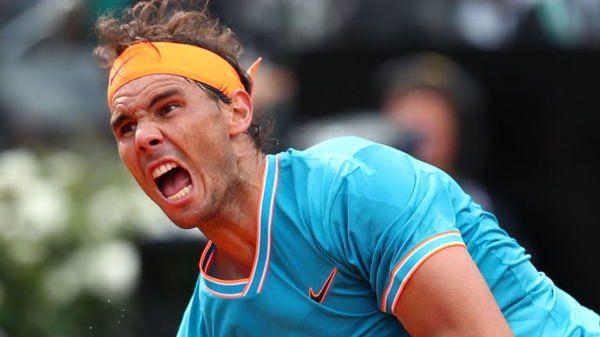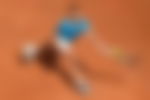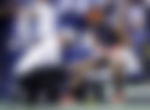
via Imago
Rafael Nadal

via Imago
Rafael Nadal
This year’s clay season will be soon kick-starting with its final tournament of the season on the Parisian terre-battue. The European clay till now witnessed different winners in the all the tournaments and the Masters in Madrid and Rome embodied the ‘Big Three’ of tennis, Roger Federer, Rafael Nadal and Novak Djokovic in their draws.
The ‘King of Clay’, Rafael Nadal lifted up his ninth title in Rome this Sunday by knocking down Djokovic in three sets. And throughout the tournament, the Spaniard bageled all his opponents on the Roman clay, except for Stefanos Tsitsipas in the semifinals.
Growing up in the Spanish cities of Mallorca and Barcelona, Rafael Nadal spent a lot of time playing on clay. The ‘Master of Mud’, Rafael Nadal has an unparalleled consistency when it comes to his dominance on that surface. A clay court and Rafa, when put together generate something more than tennis. A form of an art unfurls on the clay canvas when the Spanish maestro swings his Babolat baton.
ADVERTISEMENT
Article continues below this ad
The World Number two, Rafael Nadal has won 58 clay titles whereas his longtime foes, Roger Federer and Novak Djokovic collectively have 25 titles. These figures manifest clearly Rafa’s nonpareil success on the sludge.

via Imago
Rafael Nadal, Lasso Forehand
His left-handed lethal cross-court lasso forehands, land on the backhand side of his right-handed opponents. With the ball bouncing higher on clay, his opponents find it difficult to return Rafa’s forehands with their backhands. Nadal’s forehand shot is an aggressive one and his backhand is used for his defense.
However, on clay, the cross-court forehands take care of offensive as well as defensive part of the game. The slice backhands from Roger Federer are certainly counterbalanced by Rafa’s defensive cross-court forehands. With Rafael Nadal having two defensive weapons on clay, this designates him to be the best clay courters of all times.
Rafa’s forehands are more dominant than his backhands, the slow clay courts give him ample time to switch his to the forehand wing. For instance, in his recent match at the Italian Open 2019, where he dismantled the Serbian in the finals, the best returners in the history of tennis, Novak Djokovic came across his first break point on the match in the second set.
However, Rafa promptly effaced that point by converting a backhand stroke to a jaw-dropping forehand. The conversion rate of that groundstroke was minimal, Rafa accelerated on his toes. Most of the ATP men would have chosen to slam a backhand winner at that particular instant since it was Rafael Nadal’s pageant, he chose to save that break point with his favoured weapon.
Uncle Toni Nadal gave paramount importance to Rafa’s fitness. He made sure that Rafael Nadal trained on his agility part involving drills to ameliorate his footwork, which credits for his agile movement on clay. He is blessed with natural strength which allows him to pummel the tennis balls powerfully. And his resistance training helps him to soar that inbuilt strength.

via Imago
Rafael Nadal
The Spaniard, Rafael Nadal is one of the quickest men on ATP tour, he does it swiftly and create some angled shots with his deadly forehand. It eventually makes it strenuous for his opponents to play his returns. They just focus on giving their best to stay in the point, defend his balls rather than acing it.
The clay surface promotes spin-play. Rafa’s explosive forehands are accompanied by a full western grip and he also uses an upward swing which consequently produces more topspin. When his returns land on his opponent’s court, the bounce his high and eventually making it difficult for them to face Rafa’s topspin returns.
Rafael Nadal is one of the greatest defenders on the men’s tour. He denies to give free points to his opponents and rather drives his opponents to commit mistakes. Like Rafa says, “I play each point like my life depends on it”, and the Spaniard portrays this attitude in every match he plays. All these aspects make Rafael Nadal undaunted on clay in spades. Moreover, the red dirt allows him to slide more proficiently than any other surface.
Rafa’s first ever French Open loss was experienced in 2009 against Robin Soderling. The same year, Rafael Nadal became the first Spaniard to win Australian Open but the performance was deteriorating on the professional courts after his fourth-round loss in Paris.

via Imago
Rafael Nadal, Roland Garros 2009
Rafa did not sit back and whine upon his state back then. Rather he found solutions to liberate himself from that dilemma. He worked upon the shortcomings of his previous season and trained himself to hit flatter and deeper balls and examined the other technical dimensions of his tennis.
And the very next year in 2010, he avenged for his Paris major loss by defeating Soderling in the finals. And that year, Rafael Nadal also picked up his Career Slam at Flushing Meadows and was back on the apex of the ATP roster.
Besides his peerless skills on the court, Rafa is someone who possesses a huge amount of patience. And his diligence and perseverance towards the sport are supreme. Rafael Nadal usually does not give up during long rallies and that eventually reduces the figures of his unforced errors in a match. He contemplates on every single point he is playing no matter what the score is.
With his patience, Rafa’s game on clay is similar to that of a chess match. He executes everything step by step, engages himself in shotmaking, and patiently waits for the right moment and then slams a winner. Also, he never loses his temper and thrashes his racquet on the court out of frustration. The salient feature of patience assists Rafa to perform coherently on the slow clay courts.
Rafael Nadal has dealt with knee injuries throughout his career. During hard court events, his knee compels to him retire in the middle of the matches and tournaments. His feeble knee is gullible to injuries on the hard surfaces, but the clay surface makes him feel efficient.

via Imago
Rafael Nadal
The soreness for Rafa’s knee is less on clay when compared to other surfaces. The organic courts are less prone to injuries than the synthetic ones this enables Rafael Nadal to play productive tennis. His knee syncs with the red dirt and aids him to produce his natural game of tennis.
During practice sessions, Rafa steps on the court with an attitude of a learner, he keeps introspecting upon himself and looks into the scope of improvement in his game and the aspects of his tennis where he can master upon. In a nutshell, during training sessions, Rafael Nadal treats himself as an underdog.
“You don’t complain when you play bad when you have problems when you have pains. You put on the right attitude and right face. You go on the court every day with the passion to keep practicing,” Rafael Nadal says.
ADVERTISEMENT
Article continues below this ad
Even if he is the number one player in world Rafael Nadal pushes himself to be one step ahead of what he was yesterday. Before his matches, he incessantly trains on the tennis courts and hits the balls again and again until he achieves his level of perfection.
The mental toughness level of Rafael Nadal is simply remarkable. Even during some grueling situations, he finds a way to take himself out from that state. His mental strength was palpably visible during the greatest Grand Slam matches in the tennis history, Wimbledon 2008 finals against Roger Federer.
“You go on the court every day with practising to keep practising, that’s the mental work. That’s something that I did during all my career, not being frustrating when the things are not going well, not being too negative. Here we are. Important title, important moment. Now is the moment to keep going”, Rafael Nadal uttered after his recent illustrious victory at Rome Masters 2019 where he dropped just two service games in the entire tournament.
ADVERTISEMENT
Article continues below this ad

via Imago
Rafael Nadal, Roland Garros 2005
Undoubtedly, the Spaniard is the unrivaled clay courters in the history of tennis. On his 19th birthday, Rafael Nadal defeated Roger Federer in the semifinals of the Roland Garros 2005, one match later he was declared the second ATP player to win the French Open title on his first attempt and since then he has never abstained himself from winning on the surface.
ADVERTISEMENT
ADVERTISEMENT
ADVERTISEMENT
ADVERTISEMENT

